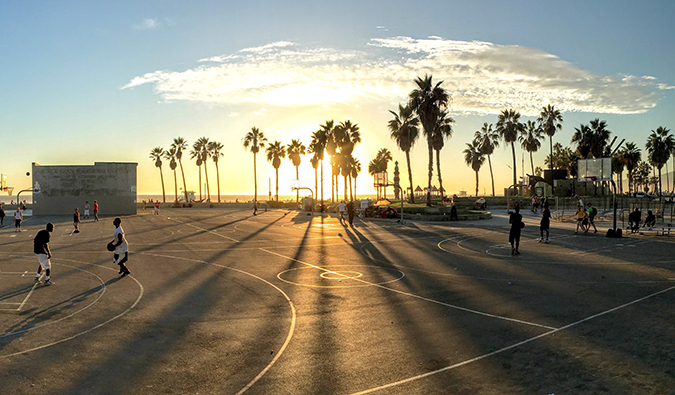
Posted: 11/29/18 | November 29th, 2018
Maybe it was the traffic. Maybe the smog. Maybe it was the apparent vanity of everyone I met. Or the hippie-dippie way of life (I’ve seen people pick meals by using a crystals). I know it was definitely in part the lack of public transportation.
While I could never really put my finger on it, there was just something about Los Angeles that just always rubbed me the wrong way.
I’d go to see friends or attend conferences and, while I enjoyed that fun, I hated the city itself.
Whenever I had to go visit, I’d just think to myself “Ugh, another trip to L.A.!”
I just never got the city.
After each visit, I always felt that if I never returned, I wouldn’t be missing anything.
Heck, I even wrote a blog post about my disdain for LA!
And then one day while I was ivisitng, I woke up and I really liked — nay, LOVED — Los Angeles.
I don’t know when it happened.
I can’t pinpoint one precise moment or event.
After all, my routine in LA has always been the same: see a few attractions, eat and drink lots, catch up with friends, maybe head to the beach, some work at WeWork, and host a meet-up.
But, one day, I just woke up, looked around, and said, “Ya know, I really like it here. I think I’ll extend my stay a bit longer.”
The more I visited, the more interesting places I discovered or was taken to, the more offbeat sights I saw, and the more I got to know the city. I learned its history. I learned how to get around, when to brave the traffic and when not to. I found markets and hole-in-the-wall taquerias and noodle shops. I had too many martinis at the historic Musso & Frank’s.
And then, when I was there last week, it hit me.
I realized I hated LA for the same reason I originally hated Bangkok.
And now love LA for the same reasons I fell in love with Bangkok.
Los Angeles isn’t built for tourists.
Yes, tourists go there. Yes, there are a lot of touristy things to do there.

But it’s not like Hong Kong, Paris, Buenos Aires, London, Sydney, or other places where you can go down a long list of attractions, drink in the culture, get around easily, and get a feel for the city in a short period of time.
No, the sprawling nature of Los Angeles, the traffic and cost of getting around, the lack of a city center, and the transient nature of its inhabitants makes it a bad “tourist” city.
To get to know Los Angeles, you have to live there. Just like Bangkok.
Like Bangkok, L.A. is requires you to stay awhile. It’s an onion with layers you need to peel back over time.
L.A. is found in the restaurants, markets, ethnic enclaves, offbeat bars, and coffee shops. It is found on hiking trails and beaches. In art and music shows.
It’s found in the vibe and the people, not in the sights.
I began to love Bangkok when I got know it beyond the temples and the tourist trail. When I found hidden markets and amazing street stalls frequented only by locals, became friends with residents, and understood how it operated, I knew why people loved Bangkok so much.
Bangkok is not a city for tourists.
It’s for residents.
Just like Los Angeles.
When I realized that, I stopped looking at Los Angeles through the lens of a tourist. When I began to look at through the eyes of the people who lived there, suddenly the city becomes alive with things to do, coffeeshops to sit in, and places to explore.
It turns out L.A. is an awesome city if you know where to look.
I just never knew where to look before.
Book Your Trip to Los Angeles: Logistical Tips and Tricks
Book Your Flight
Find a cheap flight by using Skyscanner or Momondo. They are my two favorite search engines because they search websites and airlines around the globe so you always know no stone is left unturned.
Book Your Accommodation
You can book your hostel with Hostelworld. If you want to stay somewhere other than a hostel, use Booking.com as they consistently return the cheapest rates for guesthouses and cheap hotels. I use them all the time. Here are suggested places to stay in Los Angeles:
- USA Hostels – Located right between Hollywood Boulevard and Sunset Strip, this spot is awesome with privacy pods and ensuite dorms.
- HI Los Angeles Santa Monica – A comfortable hostel where all the beach action is in Santa Monica.
- Banana Bungalow – A social hostel in Hollywood with a great outdoor courtyard area (and regular BBQs!).
Don’t Forget Travel Insurance
Travel insurance will protect you against illness, injury, theft, and cancellations. It’s comprehensive protection in case anything goes wrong. I never go on a trip without it as I’ve had to use it many times in the past. I’ve been using World Nomads for ten years. My favorite companies that offer the best service and value are:
Looking for the best companies to save money with?
Check out my resource page for the best companies to use when you travel! I list all the ones I use to save money when I travel – and I think will help you too!
Looking for more information on visiting Los Angeles?
Check out my in-depth destination guide to LA with more tips on what to see, do, costs, ways to save, and much, much more!
The post Changing My Tune: How I Learned to Love L.A. appeared first on Nomadic Matt's Travel Site.















































































